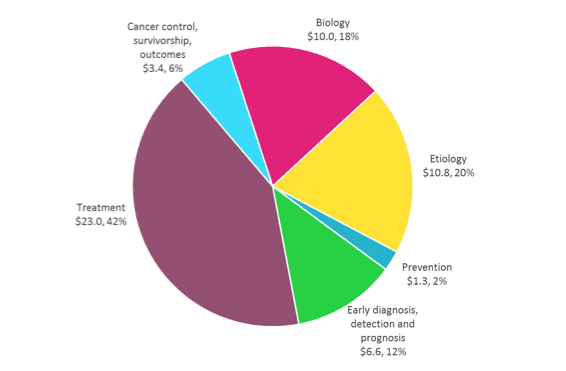BCRF maintains its leadership as the largest nonprofit funder of breast cancer research in 2016
BCRF announces a new $57-million commitment to breast cancer research for 2016-17, supporting research to more than 250 scientists at leading academic and medical institutions in 14 countries. BCRF funded research spans the entire spectrum of breast cancer, from understanding how a normal cell becomes cancer, to prevention and early detection, to developing new targeted treatments and testing novel combinations in clinical trials, to improving survival and quality of life of patients during and after treatment. Read our press release outlining key areas of research.

Another way to look at the breakdown of our research portfolio is presented in the pie chart pictured above. This reflects the “Common Scientific Outline” (CSO), a coding system established by the National Cancer Institute and International Cancer Research Partnership that is commonly used by funding agencies. The codes break down the research category accordingly:
- Biology – understanding the basic biology of cancer cells and how they divide, spread and multiply
- Etiology – understanding what causes cancer, how a healthy cell begins to grow uncontrollably and form a cancerous tumor
- Prevention – developing strategies for prevention, understanding cancer risk factors and risk-reduction
- Early diagnosis – developing new tools for cancer detection, diagnosis and prognosis
- Treatment – identifying new targets for treatment, developing new treatments and understanding the mechanisms by which treatments work
- Cancer control, survivorship and outcomes – research into population-level health, quality of life, cancer control at the population level, disparities in health outcomes and improving health outcomes
Using the CSO coding system to categorize BCRF awards provides the framework for evaluating the impact of its research dollars; it’s important as it allows BCRF to compare our grant allocation with other funding agencies such as the National Institutes of Health and other foundations, and to share program data with other funders. It also enables BCRF’s Scientific Advisory Board to more easily identify funding gaps and where emerging topics of scientific investigation fit into the overall landscape of cancer research. All of this is vitally important in maintaining BCRF’s leadership in breast cancer research and ensure that our research dollars are put to the best use to ultimately end the pain and suffering of breast cancer.
What the CSO codes do not easily show are tidy breakouts of topics that are of interest to patients and their families, donors and other non-scientific readers, topics like metastasis, triple negative breast cancer, lifestyle factors or studies in BRCA and inherited susceptibility, for instance. In fact, all of these topic areas are studied by BCRF-funded investigators.
As an example, BCRF’s 2016-2017 grant portfolio includes awards totaling approximately $18-million to study metastatic breast cancer (MBC). These research studies span the CSO categories of biology, etiology, detection, treatment and survivorship. A metastasis project focused on understanding how a cancer cells leaves the breast and enters the blood stream would come under “biology”, whereas a project testing a drug to stop the metastatic process would come under “treatment.” BCRF’s portfolio also includes awards totaling $23-million for new treatments, $15-million to understand genetics and BRCA1/BRCA2/PALB2 mutations, and $8-million in prevention and early detection. Importantly, BCRF’s research investments include projects to address health disparities as well as nearly $5-million to 27 international researchers in 13 countries outside of the US.
Learn more about our research projects through BCRF Conversations, the official podcast of BCRF, featuring interviews with the leading minds in science.






